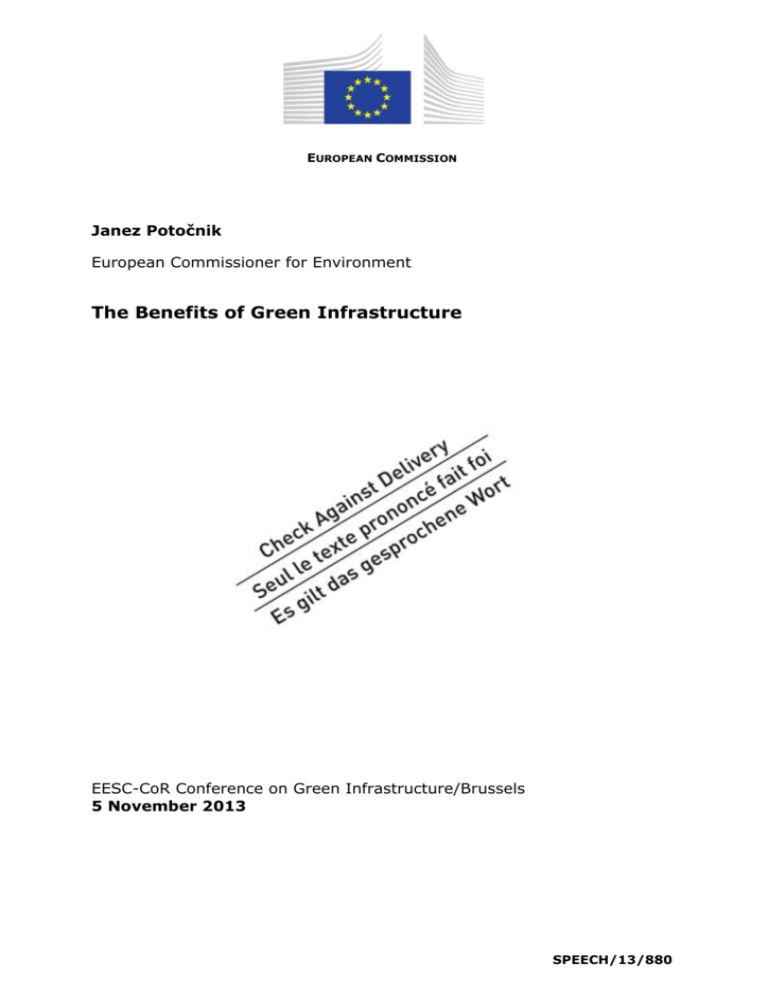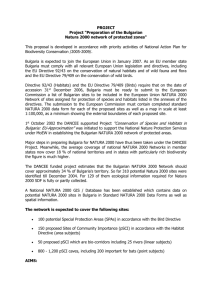DOC - Europa
advertisement

EUROPEAN COMMISSION Janez Potočnik European Commissioner for Environment The Benefits of Green Infrastructure EESC-CoR Conference on Green Infrastructure/Brussels 5 November 2013 SPEECH/13/880 Dear colleagues, ladies and gentlemen, I am very pleased to be here today to discuss the benefits of Green Infrastructure for Europe's regions and cities, the role that different actors can play at all levels to deploy nature-based solutions across the EU, and how we can work together to make it happen. However, let me first thank the Committee of the Regions and the Economic and Social Committee for organising this conference. Let me also express my gratitude to the rapporteurs from both Committees -- Annabelle Jaeger and Adalbert Kienle – for the quality of the Opinions delivered. I also want to congratulate Sandrine Bélier for taking forward the Resolution on Green Infrastructure in the European Parliament; and thank again the Lithuanian Presidency for a very stimulating lunch discussion at the October Environment Council. This strong inter-institutional support for the Commission's Green Infrastructure Strategy is very encouraging, and together with awareness-raising events like this, will hopefully result in scaling up Green Infrastructure in the EU. Some of you are probably asking yourself what Green Infrastructure is and what can it do for me? Annabelle Jaeger has already answered the first part of the question, so I will focus on answering the second. Ms Jaerger mentioned that Green Infrastructure is about using a single area of land to deliver multiple benefits, which is possible if its ecosystems are in a healthy condition. The first and foremost benefit is, of course, environmental. As you know, one-fifth of EU territory is protected as part of the Natura 2000 network, which contains the ecosystems with our highest biodiversity value. It is a core element of green infrastructure across Europe and can benefit greatly from green infrastructure developments beyond the network itself. However, there is still a lot of biodiversity outside of Natura 2000 areas which should not and cannot be neglected if the EU is to meet its biodiversity headline target by 2020. The Green Infrastructure Communication which I presented in May this year sets out some ideas on how 'nature-based solutions' can protect biodiversity both within and outside Natura areas. 2 The Opinion of the Economic and Social Committee describes very some of the benefits that Green Infrastructure can bring for the environment. For instance, the creation or maintenance of natural flood plains filter the water, stabilise the water table, store CO2, provide timber and help to link up natural habitats. Their 'grey' alternative, dikes, merely prevent floods. You will remember that we have just experienced another year of damaging floods in many parts of Europe – particularly severe floods in Mr Kienle's home country, Germany. Could it be any clearer that planning decisions to build on floodplains have been simply disastrous? Building heavy infrastructure to bank up rivers has been a waste of money; and the damaging effects of soil erosion from deforestation have also been underestimated. The focus must now turn towards investing in ecosystem services provided by flood plains, by woodland along river-banks, by forests in mountainous areas, by barrier beaches and coastal wetlands. It's also worth stressing how Green Infrastructure can contribute to climate mitigation and adaptation. What is more low-carbon than to let nature do the job? Green Infrastructure can help other sectors adapt to a changing climate, and contribute to mitigation efforts by improving carbon stocks and greenhouse gas balances. The second benefit provided by Green Infrastructure is economic. What we are seeing more and more across Europe is that Green Infrastructure solutions are often more cost-effective, more resilient and bring more long-term benefits than artificial, heavy infrastructure. If we can manage to scale up green infrastructure investments, then we can boost innovation and drive market opportunities, unlocking more sustainable growth and creating both high and low-skilled jobs. It is also a logical option in the face of current economic constraints, when we need more than ever to invest our money wisely. The third benefit which Green Infrastructure provides is social. Green spaces can improve mental and physical health and reduce heat-wave effects in cities. Green infrastructure has also played an important part in some highly successful urban rehabilitation projects, including in some of the poorest neighbourhoods. There is substantial evidence that people feel more responsible for their neighbourhood if it is green. 3 As the Committee of the Regions has rightly underlined in its opinion, the social demand for natural areas in urban environments is increasing: for leisure and recreation, gardening and agriculture, improving public health, combating economic and social inequalities; and more generally for the well-being they bring to citizens. Ladies and gentlemen, The big question today is: How can we help make green infrastructure investments happen? The Committees clearly highlight the need to provide adequate financing, whether from public or private sources. At EU level, the new multiannual financial framework provides significant opportunities. o For the first time, the Cohesion Fund will provide explicit support for Green Infrastructure. o Under Rural Development funding, 5 % of resources are intended to be spent on "integrated sustainable urban development measures", which could be used to finance urban green infrastructure. o There are also other opportunities within the reformed Common Agricultural Policy, the social funds and the LIFE Programme. So, all the openings are there, but they need to be taken up. For this to happen, Green Infrastructure needs to be prioritised in the Partnership Agreements, backed up by specific actions in the Operational Programmes. Investing in Natura 2000 also needs to be set out in the Prioritised Action Frameworks in order to attract the financial support needed. But we also know that while public funding from the EU and national budgets is essential, it will not be sufficient. Thankfully, the private sector has started to recognise the opportunities for investment in natural capital. This is a promising market, but the financial sector often perceives it as 'high risk', and is therefore reluctant to lend. Carefully targeted public funds can reduce the risk profile of these kinds of projects and attract even more investments from the private sector. 4 That is why my services are working with the European Investment Bank to set up a pilot Natural Capital Financing Facility, which should be operational next year. One of the objectives will be to mobilise additional investment in Green Infrastructure from the private sector and support the competitiveness of EU businesses in this emerging market. Beyond financing, we also need to improve the knowledge base for Green Infrastructure and promote trans-boundary benefits and opportunities for a TransEuropean Green Infrastructure Network. Here I would mention in particular the work already underway to map and assess ecosystems and their services across Europe, and efforts to integrate Green Infrastructure into the relevant policies – whether in the biodiversity context through the "No net loss initiative", or in sectoral policies such as agriculture and cohesion policy. There are already some excellent examples of Green Infrastructure being used in many countries, regions and cities in Europe, and you will hear about some of them later this morning. But if we are to draw all the benefits from Green Infrastructure which I just mentioned, these activities absolutely need to be scaled up. I'm confident that in our discussions today some ideas will emerge on how to make this happen. I would like to close by highlighting four points which have emerged from my discussions with Member States, Parliamentarians, the Economic and Social Committee and the Committee of the Regions: o First, the exchange of best practices is essential, whether for implementing large and cross-border Green Infrastructure or for improving the knowledge base and information for businesses, administration and spatial planners to make the right decisions. Capacities for information sharing need to be improved at all levels; 5 o Second, awareness raising and training are needed to enable the broad-scale take-up of Green Infrastructure on the ground. Green Infrastructure is an ideal tool to communicate the importance of nature to the citizens, but more efforts are needed. Academic programmes for the education and training of specialists in Green Infrastructure should be set up; o Third, citizens science and participatory processes have an important role to play in planning, implementing, maintaining and monitoring Green Infrastructure. The best Green Infrastructure projects are those which have a strong involvement of citizens, in particular at local and regional level. o And fourth, the private sector also has an important role to play in the deployment of GI. Specific structures and initiatives need to be set up to ensure this happens, and I have mentioned the Natural Capital Financing Facility as one that the Commission is actively promoting, along with the EU Business and Biodiversity Platform. National, regional and local authorities, businesses and civil society all have a role to play in scaling up Green Infrastructure across the EU. Ladies and Gentleman, All the institutions sitting around the table – Council, European Parliament, Committee of the Regions and European Economic and Social Committee are strongly supporting Green Infrastructure concept and Commission’s proposal. The interest in Green Infrastructure is high, sometimes even higher than expected. I was informed that for today’s conference the organisers were forced to change the initially envisaged room for a bigger one. But if we will not collectively switch from talking the talk to walking the walk and change our own commitments to the follow up actions, nothing will really change on the ground. This is why I will end with a call to all of you, actually all of us, to engage in making Green Infrastructure a true European success story. Together we can show how investing in nature-based solutions can help achieve our environmental objectives, improve the well-being of our citizens, create jobs and business opportunities – and all that with cost-effective use of scarce public funds. It is a real win-win possibility. We can simply not afford not to make the most of it. 6 Thank you for your attention. 7





